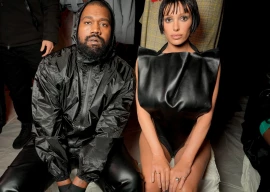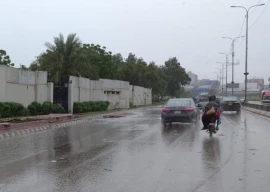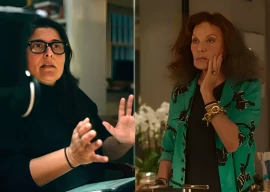
KARACHI: It is difficult to decipher a trend if the victims are picked off one by one each day. Isolated reports fail to give the full picture. But now the police are fairly certain that the sectarian revenge killings have taken a new turn: groups and families are being targeted rather than the individual.
In the last 30 days, six similar homicides suggest that the Deobandi and Shia militant wings are interlocked in a frightening new spiral.
It started on August 18, when suspects from the banned Sipah-e-Mohammad Pakistan killed nine friends affiliated with the Deobandi school of thought in Gulberg and North Karachi within two hours. District West DIG Akram Bharoka believes that the Deobandis were targeted in North Karachi primarily because it was their home territory.
The police suspect that the killings were an instant reaction to the bomb blast at the Imamia Student Organisation’s Youm-e-Quds rally which took place earlier that day.
A few weeks later, on September 5, suspects from the banned Lashkar-e-Jhangvi or the outlawed Sipah-e-Sahaba Pakistan gunned down an advertising icon and the chairperson of the Islamic Research Centre Trust, Mukhtar Aazmi, and his son Mohammad Baqir. The suspects opened fire on Aazmi’s car as the father and son were heading home from work. Aazmi’s grandson, who was also in the car with them, was injured.
Around 19 days later, four brothers affiliated with the Ahle Sunnat wal Jamaat were shot dead by motorcyclists near Disco Morr, North Karachi. On September 26, 60-year-old Mohammad Raza and his two sons, Kumail and Abbas, were killed in Pan Mandi, Napier Road. As the killings continued, on Wednesday night, three more Shia men were shot dead in two separate murders. In Gulbahar, four men on two motorcycles opened fire at 42-year-old Zafar Ahmed Alvi, said the Rizvia police. According to DSP Rustam Khattak, the suspects started shooting at other people as they tried to escape and killed Zahid Ali Jaffery, 45, and injured three men identified as Altaf, Iqbal Ahmed and Jackson Pervez. The DSP believes that Zafar, who was associated with the Muttahida Qaumi Movement was the prime target. Thirty-five-year-old Zaheer Abbasi was gunned down by two men on a motorcycle in Gulberg after he dropped his son off at school, said the Samanabad police. They believe that he was killed in a sectarian attack. Another Shia man identified as Nisar was shot dead while his brother and cousin were injured in a targeted attack in New Karachi by four men. However, the police suspect that Nisar was killed for personal reasons.
Changing trends
From an eye for an eye in the 1990s, sectarian attacks have grown to also target mosques, imambargahs and important party workers, religious leaders and scholars.
Law enforcers claim that the militants who went to prison for sectarian killings in the 1990s are free now and might have helped train a new set of killers.
According to Crime Investigation Department’s SSP Fayyaz Khan, one of the groups had the support of Tehreek-i-Taliban Pakistan. “There are several reasons behind the sectarian violence but the recent cases are coming up because of Eidul Azha,” he said. “In the weeks leading to Eid, these people like to flex their muscles to show their strength and collect donations. If you link the previous events together it sort of makes sense - Deobandi scholars were killed and then Shias were killed.”
So far the only suspect the police have been able to arrest was an alleged hitman from the banned Sipah-e-Mohammad Pakistan. They claim he killed seven Deobandis near Disco Morr. DIG Bharoka said that the suspect had confessed to being from a militant group which was trying to increase sectarian violence. “We cannot fight this overnight,” he said. “We need to divide into teams and work on solving these cases. That is the only way to combat sectarian violence.”
One of the big sectarian killing cases in 1994 was the attack on Major Alay Ali Jaffri’s house in PECHS Block 6. His house, which was also used as a small imambargah and ibadatgah, was attacked one morning by men allegedly from the SSP. CID’s SP Mazhar Mashwani, who at the time was an ASI and in charge of the case, says that the suspects had tied the men up with their cummerbunds and opened fire on them. Five people were injured and two, including Jaffri, were killed. “When we [the police] got there, we had an encounter with the suspects,” he said. “Two of them were killed and we arrested three others, including Shahid, Farhan and Imran.” Mashwani was promoted, became a sub-inspector and received a medal from the president. However, the suspects were later released on bail by the court.
Another well known case in the 1990s was the murder of Deobandi scholar Maulana Habibullah Mukhtar near Guru Mandir in 1997. The police managed to arrest two suspects, Tanveer Abbas and Saleem Jaffer, who were later acquitted by the court. They believe that the main suspect, a man identified as Rana, was hiding in Iran. Around a year or so ago, Abbas was murdered in Rizvia. The police suspect that he might have been killed in a mugging.
While talking to The Express Tribune, Mashwani said that these target killings are incomparable. “We suspect that these people are not acting alone. They have a strong back-up system,” he said. “In the 1990s, a target killer was hired with a clear-cut reason to kill someone. Like if someone wanted to kill me they would hold against me the fact that I am a policeman and have arrested a lot people. They would monitor my movements and strike within a few day. Now, they are just killing families - there is no clear direction just the motivation to kill.”
DEOBANDI (Hardline Sunni)
Lashkar-e-Jhangvi
Established: 1996
Leadership: Mohammad Ajmal aka Akram Lahori, Malik Mohammad Ishaq, (late) Riaz Basra
Headquarters: Jhang, Rahim Yar Khan, Lahore, Karachi
Legal status: Banned
Strongholds: Presence in southern Punjab and Karachi, as well as Balochistan, because of its close links with the Sipah-e-Sahaba Pakistan (see right)
The LeJ is a breakaway group of the Sipah-e-Sahaba Pakistan (dark orange) that has been implicated in and has taken responsibility for attacks on Shias as well as the
attack on the CID headquarters in Karachi and the Sri Lankan
cricket team in Lahore
Sipah-e-Sahaba Pakistan
Established: 1985
Leadership: (Free) Ahmed Ludhianvi, Orangzaib Farooqui
Headquarters: Jhang
Legal status: Banned
Strongholds: Support in key urban areas of Pakistan as well as rural Sindh and southern and central Punjab
The SSP was founded by Haq Nawaz Jhangvi and was reportedly propped up by the establishment as a counter to what it saw was increasing Iranian and Shia influence in the country. It has contested elections in the past and plans to do so in the future. It is a member of the Difa-e-Pakistan Council, a coalition of religio-political parties.
SHIA
Sipah-e-Mohammad
Established: 1993
Leadership: Ghulam Raza Naqvi, Munawar Abbas Alvi (behind bars)
Headquarters: Lahore, Karachi
Legal status: Banned
Described as a Shia group responsible for executing revenge attacks for the murder of Shias, and opposes the Sipah-e-Sahaba Pakistan (see left). Earlier, members had broken away from the Tehrik-e-Jaffaria Pakistan.
Published in The Express Tribune, September 28th, 2012.
Correction: In an earlier version of this article, Ghulam Raza Naqvi and Munawar Abbas Alvi were mentioned as leaders of Sipah-e-Sahaba Pakistan. The error has been fixed.
COMMENTS (22)
Comments are moderated and generally will be posted if they are on-topic and not abusive.
For more information, please see our Comments FAQ

















































Sri Lankan team was secretly Shia, thats why LeJ targetted it.
It's sad it has been happening from so long and not much in being done about it. Ruthless killings of innocent and honestly no gains. The war is bound to intensify if it is not taken seriously and not much done about it.
@Jameel ur Rasheed A Sunni is a MUSLIM. A Shia is a MUSLIM. And if I have respect and appreciation for the the MIGHTY ALLAH and its PROPHET MOHAMMED (PBUH) then you should be also have the same feelings!!!!
The biggest QUESTION in Pakistan is WHO is MUSLIM? Is it the salafi, the deobandi, the sufi, the sunni, the shia, the ahmedi, the balochi, the pakhtoon, the sindhi, the panjabi ? The time has arrived that 95% of PAKISTAN to recognise they are MUSLIM. If only THAT realisation sets in the mind of the Pakistani then will it be able to live peacefully within its communities, if not then as a PEOPLE you are DOOMED. The problem is not religion or ISLAM. Purely it is identifying oneself with ALLAH and following the teachings of the PROPHET MOHAMMED (PBUH).
Why does the killing of Sunnis go unsaid and unheard and any shia killed is so much circulated in media??
@sana: It's not prejudiced against Sunnis, it just truthfully portrays who has been at the receiving end in this sectarian madness.
Learn to accept facts and live with them.
It's a jungle in Pakistan - Karachi are there any humans left? Deplorable, but words on the web won't be read by these murderers.
article is prejudiced against sunnis
My head hurts just trying to understand Sipah-e-xxx, Laksher-e-yyy, difa-e-zzz and who is against who? I count my blessings that with my little brain, I am not in around these areas. I would have grown old just trying to memorize all the different groups, their motivations, religious origins.
..pc
Those who think that disco mor incident is an isolated one should correct them selves about an year back three brother affiliated with SSP killed in the same area they own a bakery, a mosque in the same area name Bab Ul Islam was also attacked in 90's in Ramadan during taraweeh killing several namazis murders of so many big names of deobandi school in Karachi like Yusuf Ludhyanvi Mufti Shamzai Mufti Ateeq ur Rehman can't be ignore and in all these murders Shia groups are prime suspects same is with Shias who loose hundreds of doctors religious leaders and innocent Shias murdered in cold blood for just being Shia by suspected Sunnis. Interestingly the core of militants of both the groups are not from Karachi SSP dominated by Saraikis and pathans and Shias dominated by people from gilt baltistan and hazara. It is the duty of both Shias and Sunnis of karachi to stop these people in their ranks otherwise no will be safe in future
Looks like a sectarian war is inevitable. Only the poor from both sides will suffer. I call on these religious leaders to themselves fight it out and save others from this war.
I am having a big time prob believing anything these religious leaders have to say.
ASWJ or deobandis have a fight with other sunni sects as well. They have been fighting for control of masjids in Karachi. How does one conclude that the single incidence of killing 4 brothers was committed by sipah-e-Mohammad and not the other rivals?
These sectarian killings show the horrible consequences of bringing religion into politics. Politics through religion spells disaster. Pakistan stands a much better chance to survive and progress by separating religion from politics.
@Abdullah: can you compare here the stats? and tell us when these innocent LeJ men killing started? and while you are at it please also tell us how many shia doctors, engineers, scientists and teachers have been martyred? these animals don't realize that doctors, engineers, scientists and teachers are the assets of any country not community :-/
So not only Shia are killing Deobandis but have also made Ghulam Raza Naqvi into the ranks of Lashkar Jhangvi, ET never surprises you in incorrect, dishonest and in-factual reporting. Shame!
It is a very biased report. Is there any comparison of shia killing with deobandi killing???
they only arrested person happens to be from the community that is being targeted since 1980s and yet the real perpetrators of sectarian violence are roaming freely in Pakistan
bravo Pakistan
Not a good sign at all...